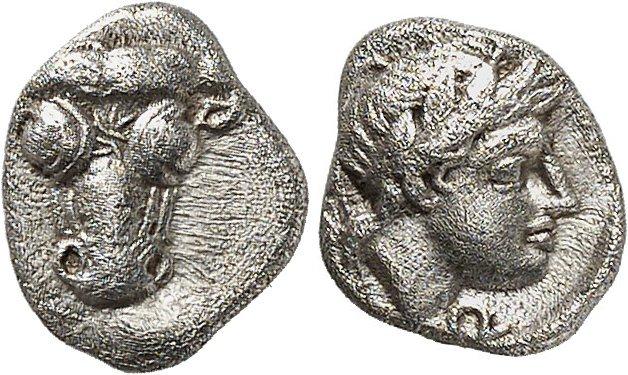S 1923 - Phocis (various mints) (Phocian League), silver, obols (356-346 BCE)
From SILVER
356 BCE - 346 BCE Silver 2,370 kg
Description
| ObverseInscription or printing placed on the obverse.: | Bull's head facing |
| ReverseInscription or printing placed on the reverse.: | Φ−Ω (Greek).Head of Apollo r. |
Mint and issuing power
| MintIdentifies the place of manufacture or issue of a numismatic object.: | Phocis (various mints) | Ancient regionAncient region.: | Phocis | Modern countryModern country: Greece | AuthorityIdentifies the issuing power. The authority can be "pretended" when the name or the portrait of X is on the coin but he/she was not the issuing power. It can also be "uncertain" when there is no mention of X on the coin but he/she was the issuing power according to the historical sources: | Phocian League |
Chronology
| FromIdentifies the initial date in a range assigned in a numismatic context. | 356 BCE | toIdentifies the final date in a range assigned in a numismatic context.. | 346 BCE | PeriodTime period of the numismatic object.: Classical 480-323 BC |
Physical description
| MetalThe physical material (usually metal) from which an object is made.: | Silver |
Median weightMedian of the weights of numismatic objects (in grams). in grams | 0.90 | DenominationTerm indicating the value of a numismatic object. Examples: tetradrachm, chalkous, denarius.: | obol |
StandardStandard.: |
Image

S1923 Phocis obols Gr. V.jpg [1]
References
| Die study referencePublication of the study: | Williams 19721Williams 1972, p. 121-130, n° 329-331, 356-367, 406-410 (Period V) | ||
| Coin series referenceReference to coin series study: | Sear I2Sear I, n° 2354 | ||
| Coin series web referenceCoin series web references: | |||
Obverse dies distribution
| FrequencyFrequency of specimen in distribution. ᵖ | Number of obversesNumber of obverse dies. ᵖ (o) | % (o) | Number of coinsNumber of coins. (n) | % (n) | Die nameName(s) of the die(s). |
| 1 | 16 | 88.89 | 16 | 80 | 230, 250, 251, 252, 253, 254, 255, 256, 258, 259, 260, 268, 269, 270, 271, 272 |
| 2 | 2 | 11.11 | 4 | 20 | 229, 257 |
| Total | 18 of 18 | 100 | 20 of 20 | 100 |
Reverse dies distribution
no distribution is available
Quantification
| Number of obversesNumber of obverse dies. ᵖ (o) | 18 | Number of singletons (o1)The number of singleton coins. ᵖ | 16 |
| Number of reverse diesNumber of reverse dies. (r) | 18 | Number of coinsNumber of coins. (n) | 20 |
| Coins per obverse dieNumber of coins per obverse die. (n/o) | 1.11 | Coins per reverse dieNumber of coins per reverse die. (n/r) | 1.11 |
| Reverse per obverse ratioRatio of obverse dies divided by reverse dies. (r/o) | 1 | Percentage of singletons (o1)number of coins (n) divided by the number of singletons (o1) ᵖ | 88.89 % |
| Original number of dies (O) (Carter 1983 formula)The estimation of the number of coins according to Carter 1983 ᵖ | 131.68 | Coins struck if 20,000 as average productivity per dieCoins made if the average productivity for obverses (according to Carter) is 20,000. ᵖ | 2,633,600 |
| Original number of dies (O) (Esty 2011 formula)The estimation of the number of coins according to the singleton formula in Esty 2011 ᵖ (O) | 180 | Survival rate if 20,000 as average productivity per dieSurvival rate if average productivity is 20,000. ᵖ | 0.00001 |
| Coverage (o = % of O) (Esty 1984 formula)Esty 1984 - coverage (% of O) ᵖ (o = % of O) | 20% | Die productivity if survival rate 1/2,000Average productivity if survival rate is 1/2,000. ᵖ | 303.77 |
| Weight of silver (in kg) if 20,000 coins per die (O = Carter formula)Carter 1983 * Median weight * 20000 (*10 if gold or electrum) ᵖ | 2,370 kg <br /> 2,370 kg | Die productivity if survival rate 1/5,000Average productivity if survival rate is 1/5,000. ᵖ | 759.42 |
Remarks